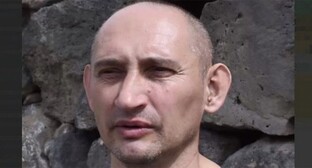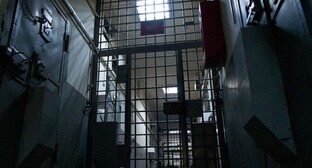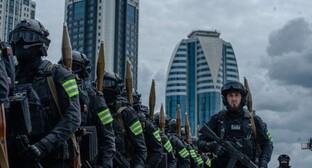29 May 2003, 03:12
Anapa
Seaside climatic and mud-bath (mostly children's) health resort of all-Russian significance. City of kray subordination, rayon (sector) centre in Krasnodar kray (region), 160 km west of Krasnodar and 52 km north-west of Novorossiysk.
Located on the Black Sea coast of the Caucasus, on a high north-east coast of Anapa Bay, surrounded by spurs of the Great Caucasian Ridge. Anapa is the terminal railway station of a branch of the Krasnodar - Krymskaya - Kavkaz line. The city is located on the Novorossiysk - Simferopol highway. Population (1992 est.) 56.7 thousand. (1959 est.) 18.5 thousand, (1979 est.) 34.4 thousand.
Anapa is the most sunny place on the Black Sea coast of the Caucasus, the average annual number of overcast days being 48. Mediterranean-type climate. Winter is mild, with an unsteady snow cover; the temperature in January averages to 1?C. Spring is short; warm weather establishes from mid-April. Summer is very warm, sunny, long-lasting; the temperature in July averages to 23?C; heat is softened by sea-breezes. Autumn is warm. Precipitations of about 400 mm a year (mostly as rain), the maximum being reached in December. The bathing season lasts from May 15 to October 15. The seawater temperature in August is 24?C, in June, September 19 - 20?C.
In ancient times, the place of present Anapa was occupied by a settlement of the Sinds, an ancient city of Sind harbour (or Sindica). Having been annexed to the Kingdom of the Bosporus (from the 4th century B.C. to the 3rd century A.D.), it was referred to as Gorgippia. It was the Genoa colony of Maia in the 14th century. In 1475, it was seized by Turkey. A strong Turkish fortress was built here under command of Sultan Abdulhamid with help of hired French engineers in 1781 - 1782. During Russian-Turkish Wars of the late 18th and the early 19th centuries, the fortress was repeatedly besieged by Russian troops, who seized it three times (in 1791, 1808 and in 1828). It was finally annexed to Russia under the 1829 Treaty of Adrianople. In 1836, the stanitsa (Cossack village) of Nikolayevskaya was founded. City of Anapa since 1846, health resort since 1866. In the second half of the 19th and the early 20th centuries, the city was included into Temryuk section of Kuban oblast (province). The main occupations of inhabitants of Anapa were trade in grain (mainly for export) and fishery.
Resort construction in Anapa began at the end of the 19th century. The first sanatorium of Doctor V.A. Budzinsky was opened in 1898, a therapeutic mud bath of this sanatorium in 1902; the Bimlyuk sanatorium was opened in 1905 (for patients with bone tuberculosis). Development of the health resort proceeded in the 1920 - 30s. During the Great Patriotic War of 1941 - 1945, the resort was occupied by Nazi aggressors (from August 31, 1942 to September 21, 1943); it was completely destroyed and fully re-built only in the 1950s.
In 1991, the health resort operated 8 sanatoriums, 6 boarding houses with treatment for adults with children (4,000 beds), 26 boarding houses and rest homes (7,780 beds), 2 tourist centres, children's improving camps (including Zhemchuzhina Rossii, Lastochka, etc.). It provided out-patient treatment as well as board and treatment authorisation. A resort polyclinic with a medical beach also functioned.
Alongside with the primary natural medical factor, which is the climate (sea bathings, sun baths), the health resort uses medical sulphide silt etc. muds (Lake Chemburskoye, the Vityazevsky Estuary and Lake Solyonoye). They are used in fangotherapy to treat patients with diseases of the locomotive system, the nervous system, gynaecological illnesses. Peroral treatment of digestion organs involves mineral waters: carbonaceous sodium hydrocarbonate-chloride water containing iodine and boron, from a spring near the stanitsa (Cossack village) of Raevskaya; carbonaceous sodium hydrocarbonate-chloride water from the spring of Semigorye, near the railway station of Tonnelnaya (bottled under the trademark of Anapskaya). Grape-cure, treatment of children with diseases of respiration organs of untubercular nature, the locomotive system, blood circulation, the nervous system, the skin.
Anapa has enterprises of food-processing industry, servicing the health resort (a meat-processing plant, a dairy factory, etc.); production of building materials; a spinning and weaving mill. Environs of Anapa are engaged in wine-growing and winemaking.
The city acquired its geometrically correct lay-out with two thoroughfares paved with stone (present-day names: Ulitsa Trudyashchykhsya and Krasnoarmeyskaya Ulitsa) in the second half of the 19th and the early 20th centuries. After-war construction follows the old orthogonal gridiron. A gate of the Turkish fortress (1781 - 1782) has survived, though its walls (about 4 km long) were destroyed by Russian troops in 1791 - 1828. Archaeological diggings near the embankment (in progress since 1975) resulted in finding quarters of Gorgippia (mostly dating back to the 1st - 2nd centuries). The Archaeological Museum keeps a rich collection of antique things.




